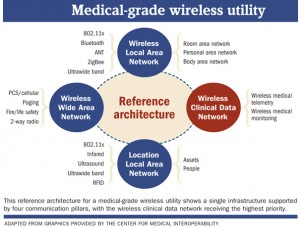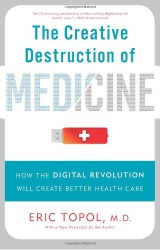Category: “Healthcare IT”
- Sell into Healthcare IT? These are the CIOs to follow on Twitter
- IT buying differnces between For-Profit and other kinds of hospitals – where you should be selling IT (or not)
For-Profit hospitals have dramatically shifted their buying from multiple IT solution purchases to single purchases. Government and Not-For-Profit hospitals continue to have multiple IT initiatives and purchases in the same year. This has important sales implications: don't try to sell into For-Profit facilities if they are already implementing a new IT solution - get on their next buy radar. The Dorenfest Institute for Health Information and Healthcare Information and Management Systems Society (HIMSS) have extensively analyzed the Healthcare IT space.
- 80 Percent of Healthcare Organizations Embrace the Cloud
- Sutter Health – big healthcare provider creates its own HIE
CMIO Dr. Christopher Jaeger discusses why Sutter has decided to launch its own Healthcare Information Exchange. HIE’s are gaining traction and may become a major IT driver in an ACO world.
- Only Three EMR Vendors Expand Market Share
- Goals For Meaningful Use Stage 3
- Understanding the new hospial utility: wireless
- The Creative Destruction of Medicine: How the Digital Revolution Will Create Better Health Care
- Meaningful Use – carrots are over, time for the stick
- Are Medical Device Companies Taking Cyber Security Seriously?
- The State of the EHR Market
The EHR market succinctly described – size, market, players.
Five years after ACA’s passage billions of dollars has been poured into the transition to electronic health records. CMS has paid out more than $14.6 billion to hospitals and health systems for the use of EHRs. The EHR market is expected to reach $9.3 billion annually by the end of 2015.
However a once-crowded field of vendors has narrowed significantly. “At the end of 2013, 10 EHR vendors accounted for about 90 percent of the hospital EHR market, based on meaningful use attestation data from CMS: Epic, MEDITECH, CPSI, Cerner, McKesson, Healthland, Siemens, Healthcare Management Systems, Allscripts and NextGen Healthcare.”
Only three, Epic, Cerner and MEDITECH, have more than half of the acute-care EHR market and they are the only companies having experienced market growth in 2013.
- Clinical decision-support (CDS) software becomes mandatory before ordering Imaging Studies
Starting January 1, 2017, physicians ordering advanced diagnostic imaging exams (CT, MRI, nuclear medicine and PET) must consult government- approved, evidence-based appropriate-use criteria, namely through a CDS system
- Supply Chain Software – a great sales opportunity
In fact, supply chain costs are one of the biggest expenses in any hospital's budget. At close to 40 percent of the operating budget for some institutions, the supply chain represents the second largest expense after labor costs. Because the supply chain occupies an outsized space on the balance sheet, implementing more effective inventory management strategies and improving supply chain performance can have a significant impact, with reductions of 10-12 percent possible with even moderate supply chain improvements.
- EHR – 2014’s biggest spend, biggest disappointment
- The Most Exciting New Technology: 3 CIOs Reflect
- $800,000 HIPAA fine – are you taking your customer’s security issues seriously?
Parkview agreement was the 21st monetary settlement reached between the OCR and healthcare provider organizations, drugstore chains and health plans over HIPAA violations since 2008. Coupled with one imposition of a monetary penalty, these enforcement activities have yielded payments exceeding $25.9 million.
- Higher volumes, less revenue – is big data the answer? Hospital execs think so
- Transforming Health Care: The Financial Impact of Technology, Electronic Tools and Data Mining
Written by the CIO of Kaiser Permanente Phil Fasano, Transforming Health Care combines healthcare, technology, and finance in an innovative new way that explains the future of healthcare and its effects on patient care, exploring the emergence of electronic tools that will transform the medical industry. Valuable for insights into Kaiser Permanente as much as for Healthcare and IT.
- Without considering data security you won’t sell much into Hospitals
- Carestream adds pro-active monitoring to their PACS to prevent problems
- Tips for Hospitals buying IT software and services
The costs of a failed IT implementation are huge. Typically a buyer can only recoup the cost of the software. Unrealized expectations, ROIs that resemble fiction instead of fact, and the monumental task (not to mention cost) of redoing a HIS, EHR or any other IT change don't get compensated. Here are tips that hospitals can use to protect themselves and sellers should know in order to sell successfully.
- 2014 – Where are IT Dollars going to be spent? Hint PACS and RIS only get 29% of the money
- Large IDN forms in Wisconson
Froedtert & The Medical College of Wisconsin health system today comprises the Froedtert Hospital in Milwaukee, Community Memorial Hospital in Menomonee Falls, and St Joseph’s Hospital in West Bend, along with more than 30 clinics.
- In IT best of breed doesn’t win
"For at least some of the providers contemplating a purchasing decision, integration is clearly outweighing functionality," said report author Adam Cherrington in a news release. "If providers have an IPS product then they are staying put, but if they are in the market and their EMR vendor has an IPS product, then the best-of-breed products often don't even get considered."
- Where you can sell EHR solutions – 10 States With Highest, Lowest EHR Adoption
- Harbinger of things to come? A $50 million facility built to deliver around-the-clock telemedicine
- Interesting read on the state of Radiology selling
Neither vendors nor end users have fared well with the changes that have gone on with healthcare reform in the past few years. While meaningful use, ICD-10, health information exchanges (HIEs), regional health information organizations (RHIOs), accountable care organizations (ACOs), and other related acronyms are affecting the way healthcare operates, someone apparently forgot to tell the leadership at most PACS providers. They seem to ignore the realities of the healthcare marketplace and continue to hold fast to year-over-year quota increases that are virtually unattainable by sales.
- 9 out of 10 hospitals intend to increase their spend on Voice Recognition – the ROI is proven
- EHR incentive cash climbs to $24B
As of 2013, only 3 percent of eligible providers in the U.S. have not signed up to participate in the program, King said. Some 59 percent have received meaningful use Stage 1 incentives; 15 percent have received AIU (adopt, implement and upgrade) incentives only, while 17 percent have registered for the program and have not yet received incentives, while five percent are enrolled in a regional extension center only, without moving forward yet.
- An Entrepreneur’s Prescription For Fixing Healthcare: Start Innovating!
Forbes interviews Jonathan Bush is CEO and coFounder of athenahealth, Inc. about his book entitled Where does it Hurt?: An Entrepreneur’s Guide to Fixing Health Care. He shares his fundamental belief in the need for systems-changing innovations in health care. Ashoka approached Jonathan to draw him out on his vision and driving principles.






